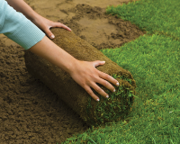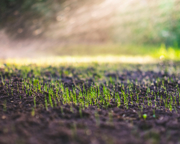Yates Account
Join now
Create a Yates account today!
Sign up to join the Yates Garden Club for monthly e-mails packed with seasonal inspiration, tips for success & exclusive promotions.
Plus if you’re a Garden Club member you can take part in the Yates Growing Community - a blog to share successes, get advice & win prizes in fun challenges along the way!

Forgot password
Enter the email address associated with your account, and we'll email you a new password.

Does your lawn look like it’s in need of a little pick-me-up? It may not be from a lack of feeding and watering, but rather, a combination of lawn thatch build-up and compaction.
A combination of lawn thatch build-up and compaction can reduce water, fertiliser and even oxygen from reaching grass roots, so no matter how much you feed and water it, the lawn doesn't seem to respond. Don’t fret! Here are our methods to fix it and get your lawn looking lush again.
How to tackle it
Removing thatch (scarifying a lawn)
What is thatch? Thatch is the build-up of living runners and dead grass debris on top of the soil. Throughout the life of your lawn, new runners grow and the old runners die off underneath this new growth. A small amount of thatch that's able to be broken down by soil microbes is beneficial to the lawn. However, this dead grass can form a thick layer, that builds up faster than soil microbes can break it down. When thatch turns into a thick spongy blanket, it prevents oxygen and nutrients from reaching the starving grass roots, so it needs to be removed.
You can use a garden rake to do a rough job, but when the thatch is thick it's best to use a scarifying rake (the type with slicing blades on the tines). For bigger lawns or to make the job less arduous, special scarifying mowers will be available from your local hire merchant.
To prepare for scarifying, mow the lawn multiple times and lower the mower on each subsequent cut across the entire area, until you have removed most signs of green growth. You may need to lower the mower gradually, doing 3-5 passes over your lawn in one session; don’t be tempted to lower your mower too much on the first cut, as this will clog the mower, make a mess of the cut and be a lot more strenuous than necessary. Once finished, feed generously with Yates Dynamic Lifter Organic Lawn Food and water in well.
The best time to do this is from October to December on warm season grasses (kikuyu) and September to November on cool season grasses (fescue, tall fescue, browntop bent and perennial ryegrass)
Aerate the soil
Heavy traffic areas – like where your kids frequently play, or the route to the clothesline – often become compacted, which prevents oxygen, water and nutrients penetrating into the soil. The beneficial microbes in your lawn soil need all these elements to survive. Because soil microbes are the main driver of grass nutrition, allowing plenty of oxygen and nutrients to circulate around the root zone is essential for a healthy lawn.
Heavy soils are naturally prone to compaction, so aeration is extra-important if your lawn is on clay, or if you're in a new build house where the original topsoil may have been removed.
For small areas, you can use a garden fork to aerate the soil. Simply push the fork down to about 10cm depth and give it a good wriggle back and forth to create large holes. Work your way around the whole lawn, making rows of holes, spaced about 10-15cm apart.
For heavily compacted soils, coring needs to be undertaken. This can be done by a hiring a coring machine, which removes ‘plugs’ of soil from the ground. While it can look a little unsightly, after a couple of mows, your lawn will thank you for it! For compacted and heavy clay soils it's highly recommended to apply gypsum to your lawn. This helps break up the clay, improves drainage and improves your soils porosity (ability to breathe).
Once your lawn is looking fresh, now it’s time to take care of it...

Mow high, not low
Regular but light mowing will keep your lawn healthy and thick. As a guideline, lawns should be mowed once a week during summer and roughly every 1-3 weeks in the cooler months. A mulching mower is an excellent method of recycling grass clippings back into the lawn, preserving valuable nutrients for new grass growth. If you find that you have excess mulch, put the catcher on and add it to your compost heap (Adding grass clippings sparingly and sandwiched in between 'brown matter' layers makes great compost).
Caution: Don't compost your grass clippings if your lawn has gotten very weedy; most home compost setups don't get hot enough to kill weed seeds, so new weeds can spread in your lovely nutritious compost. Also, take care not to mow too low – scalping a lawn is the worst thing you can do to it! The rule of thumb is to mow high and mow often, to help maintain a thick, green lawn.
The need for a feed
A good feed will work wonders for your lawn. Apply Yates Dynamic Lifter Organic Lawn Food and water in well. Other excellent choices include Yates Lawn Fertiliser Quarterly Hose-on, Yates Quarterly Lawn Fertiliser Granular and the innovative Yates Lawn Fertiliser Twice a Year.
Broadleaf weed control
Broadleaf weeds like clover, dandelions and thistles are really noticeable in a healthy green lawn. Proactively applying Yates Weed n Feed or Yates Turfix will prevent broadleaf weeds from getting established and create a pristine lawn that your neighbours will envy!
















Share
Share this article on social media